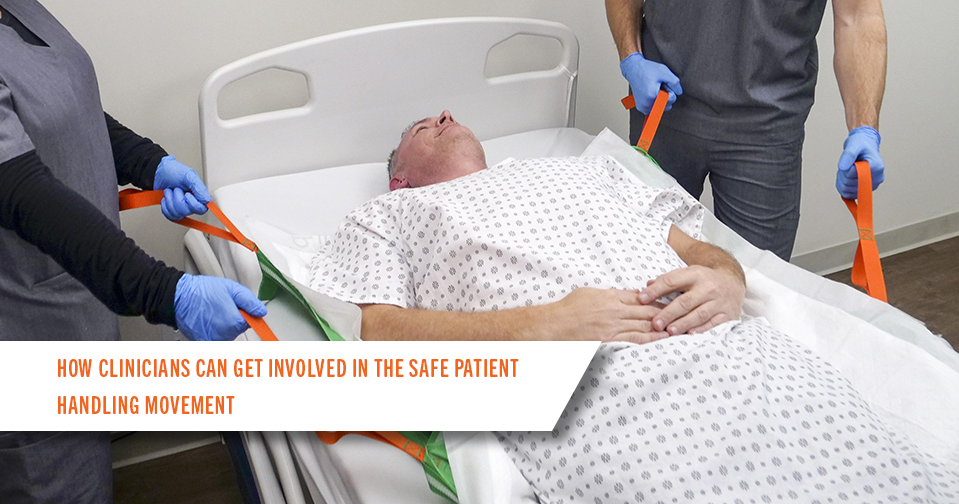Starting a Safe Patient Handling Program at Your Facility

This blog post is based on Episode 2 of the EHOB No Pressure Podcast, featuring guest Kelly Moed, MSN, RN, NPD-BC, CSPHP. To hear this episode or explore others, click here.
Unfortunately, across the US, many clinicians work in healthcare facilities without formal safe patient handling programs, leaving them vulnerable to injury and chronic musculoskeletal issues.
The good news is, more and more clinicians are becoming acquainted with the safe patient handling movement and see the value in helping establish programs within their facilities.
If you’ve developed an interest in safe patient handling, you can become a force for change within your facility. Kelly Moed, MSN, RN, NPD-BC, CSPHP shares advice and valuable resources for clinicians who wish to help start a safe patient handling program.
1. Research safe patient handling.
Implementing an effective safe patient handling program begins with understanding what a great program entails. Moed highlights a number of free resources any clinician can access to begin educating themselves.
“The American Nurse’s Association website [has] a whole section dedicated to safe patient handling and mobility,” she says. “It lists the states that have legislation, it also has a PDF file of all the safe patient handling myths, and then it tells you what the actual realities are. And it explains what it is, in a nutshell.”
These kinds of resources can easily be saved and shared with committees or decision-makers at your hospital or facility.
2. Connect with other clinicians who care about safe patient handling.
If you’re excited about bringing safe patient handling to your facility, it helps to have support from like-minded clinicians. Consider joining an industry group that’s focused on safe patient handling and mobility; Moed suggests the Association of Safe Patient Handling Professionals (ASPHP).
Moed explains, “The [ASPHP has] so many webinars, podcasts, and information online. I’m very active on a few of the committees for the Association of Safe Patient Handling Professionals …The member support is what you get when you join.”
3. Present a safe patient handling plan to your decision-makers.
Once you’ve done your research and decided to become a change agent within your facility, it’s time to develop a concrete plan.
Moed suggests that any clinicians who want to bring safe patient handling to their facility begin the planning process by asking what it is they’re trying to accomplish. Moed offers some prompts to get you thinking:
- Do you want to create a program for your unit?
- Is this a school project or an educational program for new clinicians?
- Is the aim to fill gaps in existing clinician training?
- Do you wish to address concerns about worker safety?
By defining how you hope to bring safe patient handling into your facility, you lay the groundwork for more constructive conversations with leadership around how to design and implement your program.
If you fear pushback, Moed shares that focusing on the broader costs to healthcare can be a compelling argument.
“One of the problems in the whole United States [is that] it’s not required on licensure exams, to have questions on safe patient handling, so they’re not teaching to it,” she says.
“Healthcare as a whole is at risk because it’s a public health problem,” she adds. “Society can’t afford to lose healthcare workers at this point. We’re losing them because of the pandemic. On top of that, you can’t lose workers because they’re having musculoskeletal injuries … they’re taken out of our workforce.”
When leadership ignores safe patient handling protocols, they put their clinicians, patients and facility at risk.
4. Join decision-making committees at your healthcare facility.
If you wish to advocate for implementing a safe patient handling program at your facility, it helps to be in the room where decisions are made.
Moed suggests that joining a committee is often the best way to get your ideas in front of the right people.
“If you’re a clinician [who wants] to get involved, get educated [and] get yourself on a committee. We have a lot of shared governance models coming out in healthcare, get involved and spread the word,” she says.
Change rarely happens overnight, but clinicians who are passionate about the importance of safe patient handling can begin today by educating themselves about the topic so that they may serve as an advocate within their facility.
CLICK HERE to learn more about EHOB’s solutions that help your team lift, turn and reposition patients more safely.
Did you enjoy this blog? It is based on our conversation with Kelly Moed, MSN, RN, NPD-BC, CSPHP, from Episode 2 of the EHOB No Pressure Podcast. To hear the podcast, click here.

